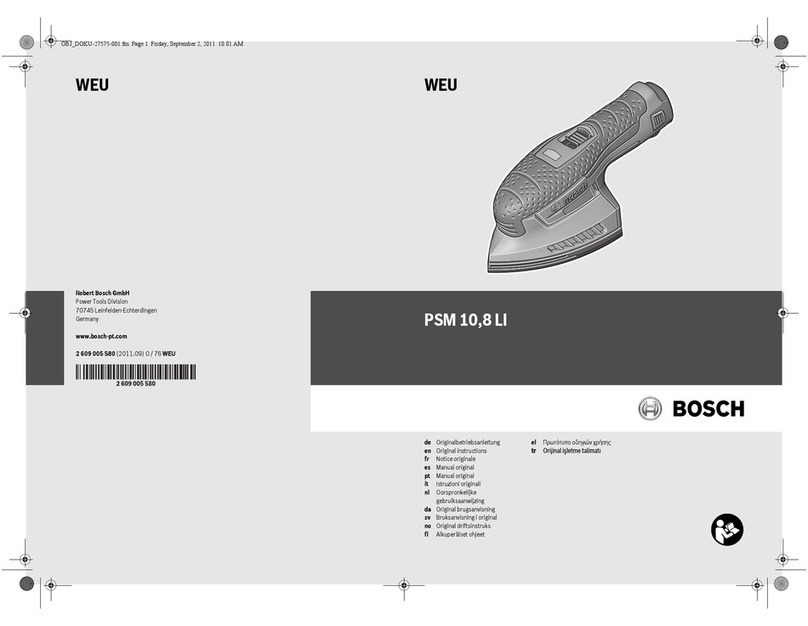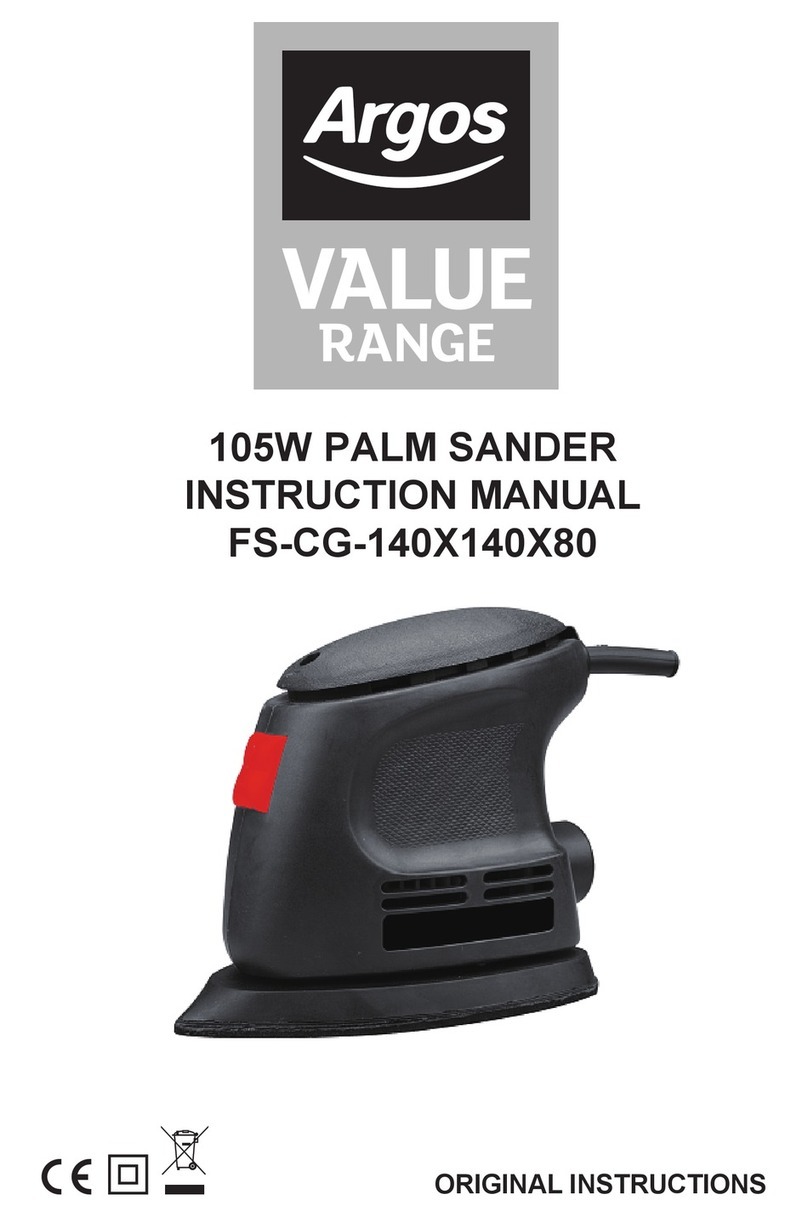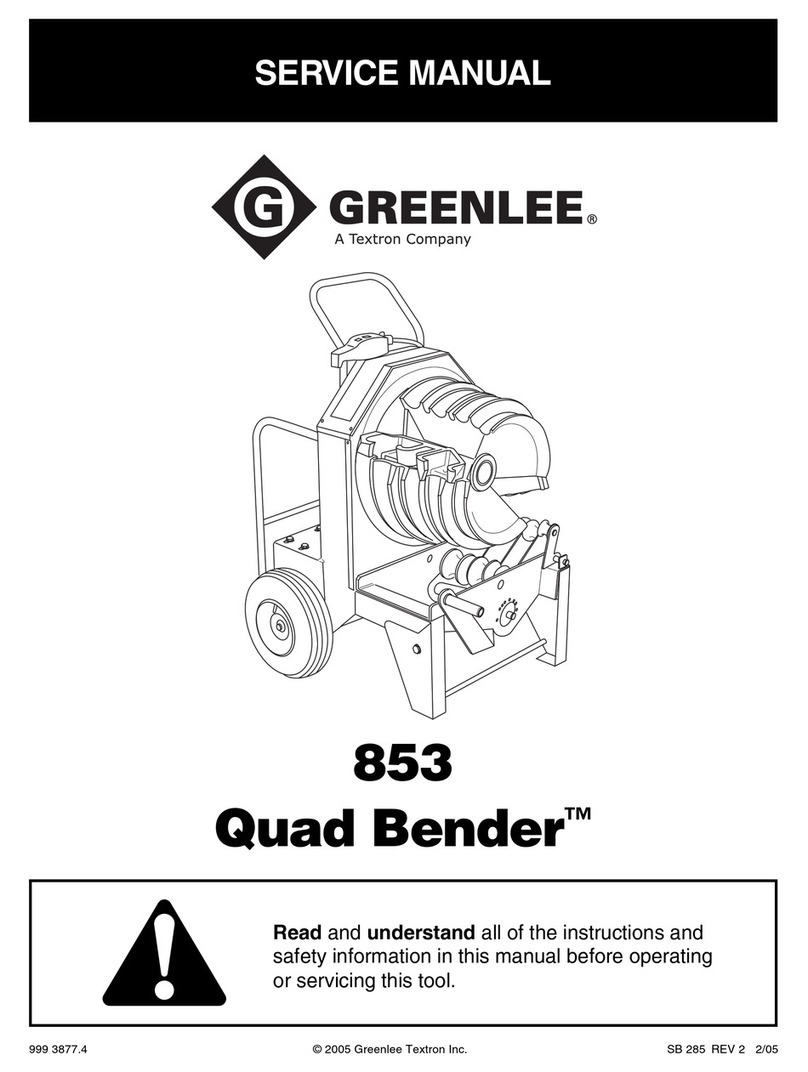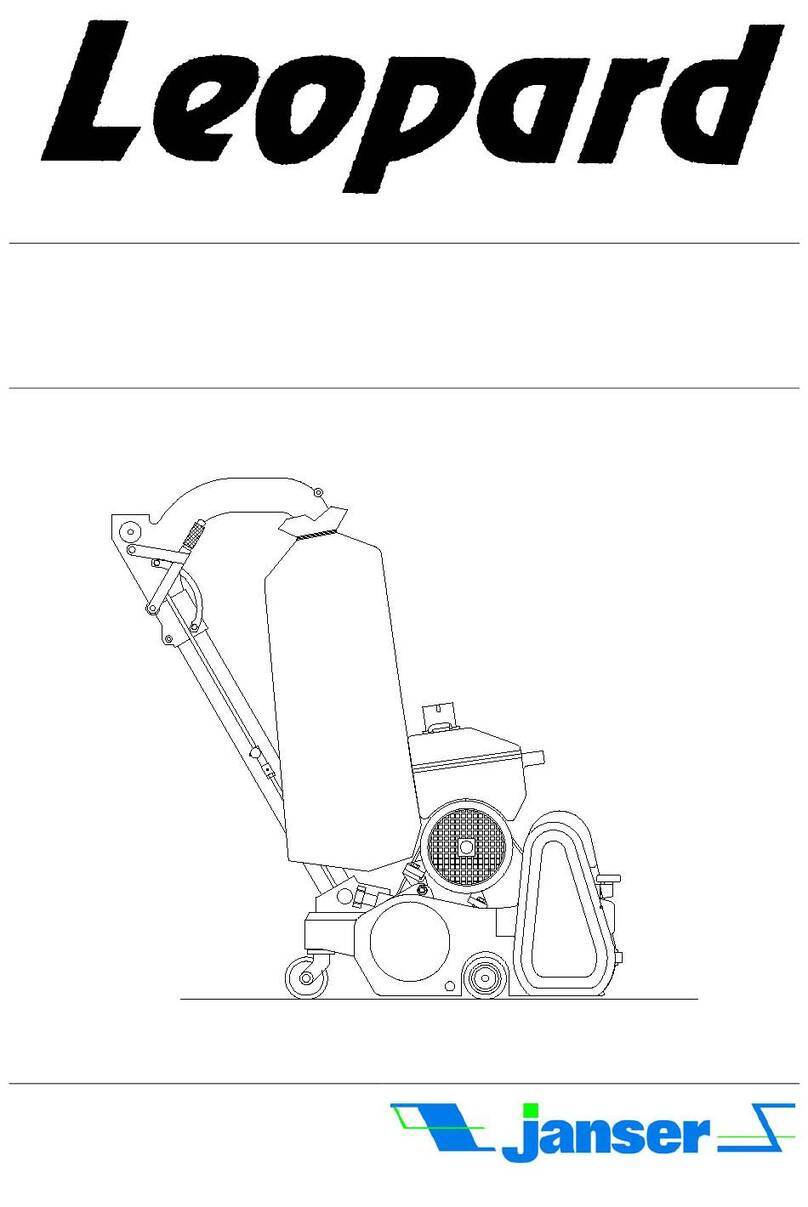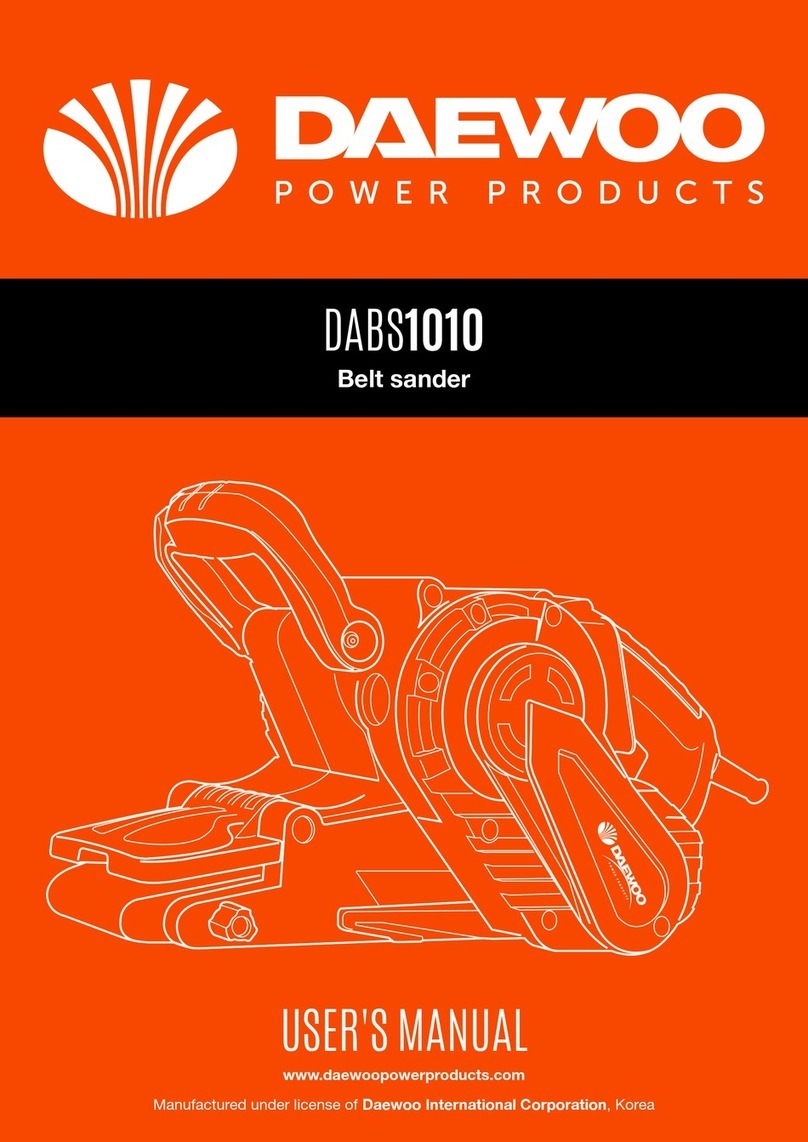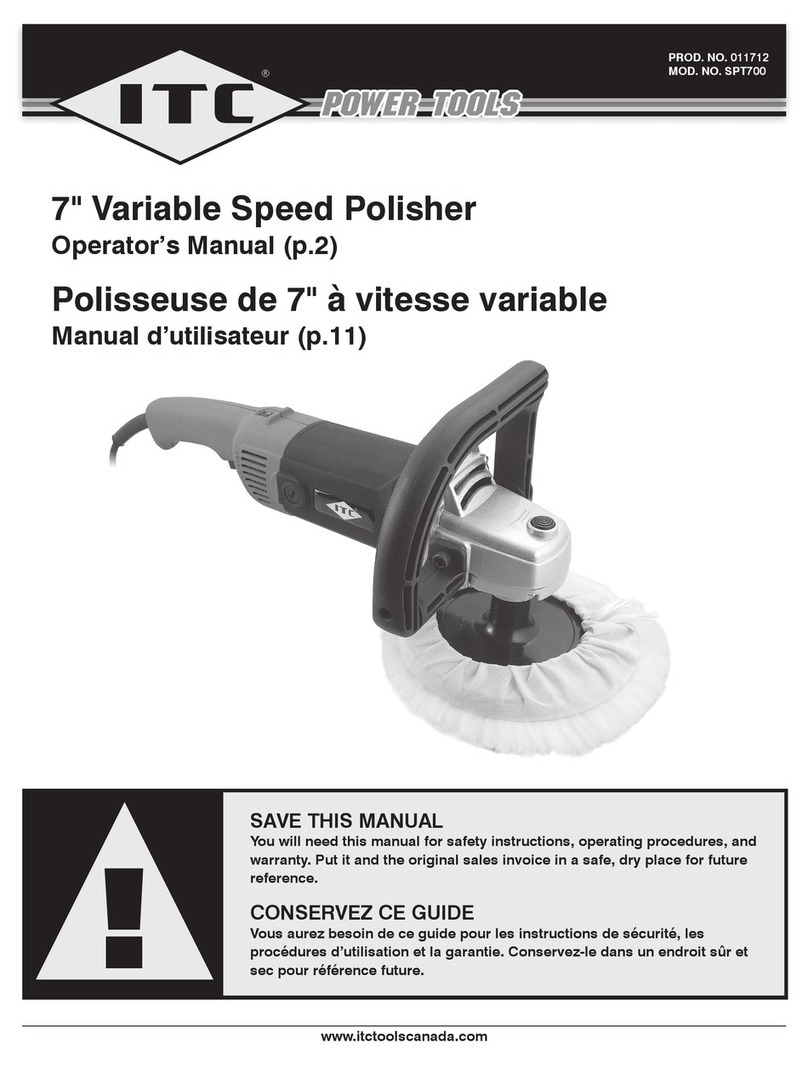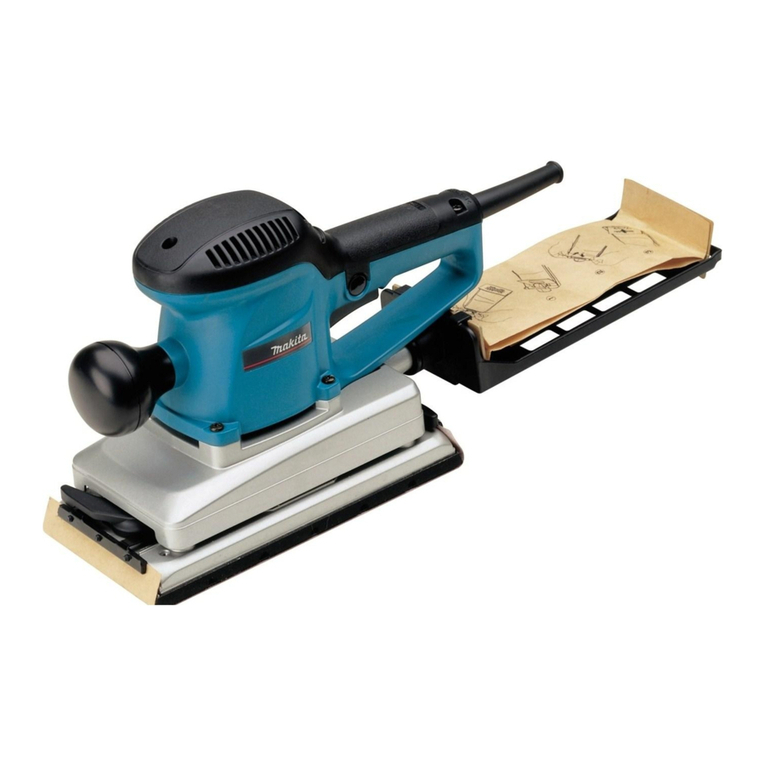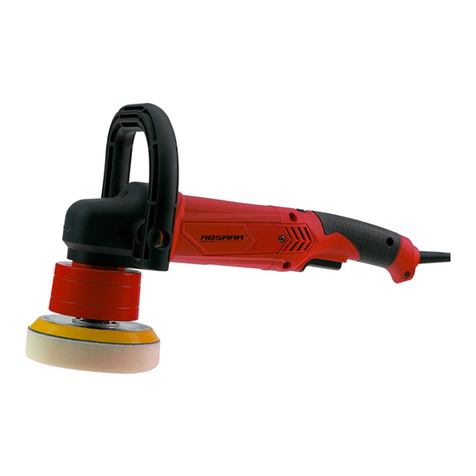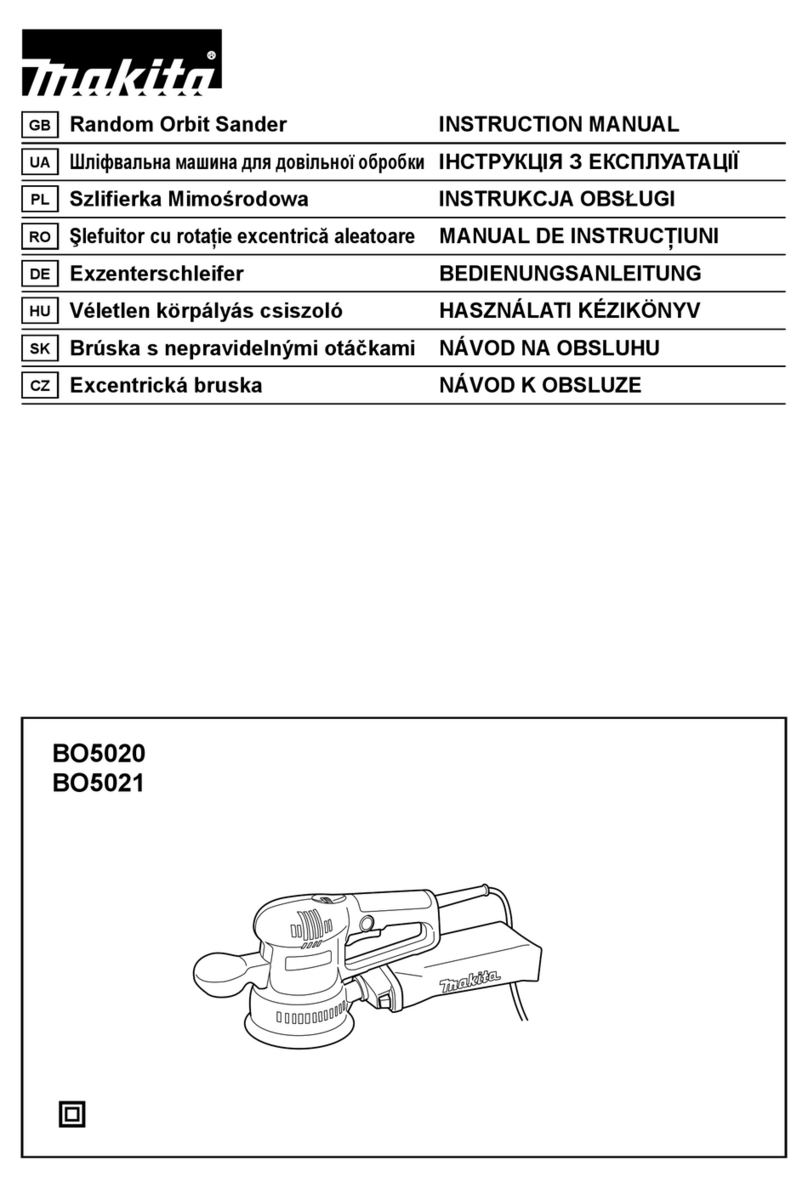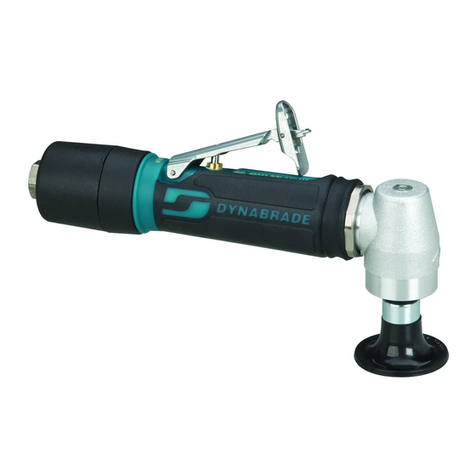HIRED-HAND HT8 EX System manual

ABC
Version 2.4 Model HT8-1.2 EX © Hiretech Part # 024965-0
OWNERS MANUAL & OPERATING INSTRUCTIONS
HT8 EX DRUM FLOOR SANDER
From Serial Number
07294 (240/240 Volt) & 03415 (110/120 Volt)

WARNING
For safe operation of this machine, read and understand all
instructions. Look for the ‘warning/caution’ symbol.
This symbol means that if you do not follow the instructions
injury can occur to the operator and damage to the
machine and floor may result.
WARNING: Risk of explosion.
Floor sanding can result in an explosive mixture of fine
dust and air. Use this floor-sanding machine only in a well-
ventilated area free from any flame, match or source of
ignition.
WARNING: Risk of fire.
Never leave the floor sander unattended with dust in the
dust bag.
WARNING: Risk of potential injury from moving parts.
To reduce the risk of injury, unplug the machine before
replacing the abrasive or carrying out any form of
adjustment or servicing.
NORTH AMERICAN SAFETY INSTRUCTIONS
WARNING: This floor sanding machine must be grounded.
This floor-sanding machine shall be grounded while in use to protect
the operator from electric shock. The machine is provided with a
three-conductor cord and a moulded three-contact grounding
type attachment plug to fit the proper grounding type receptacle.
The Green (or Green and Yellow) conductor in the cord is the
grounding wire. Never connect this wire to any pin other than the
grounding pin of the attachment plug.
This floor-sanding machine is provided with an attachment plug
as shown in sketch A. It is intended for use on a nominal 120 volt
circuit. If a properly grounded receptacle as shown in sketch A
is not available, an adaptor as shown in sketch ‘C’ should be
installed as shown in sketch B if the outlet box that houses the
receptacle is grounded. Be sure to fasten the grounding tab with a
metal faceplate screw.
MAINS CABLE WIRING - PLUG
USE & APPLICATION
This machine is intended for commercial use connected with the
laying and maintaining of wooden floors and decks.
These types of surfaces may be found both in commercial and
household environments.
SPARE PARTS
Use Hiretech genuine spare parts only for service and repair.
Use of non-approved parts will void the product warranty. See
the back cover of this manual for the terms and conditions of the
Hiretech Limited Warranty.
Hiretech reserves the right to make changes or improvements to it’s
products without prior notice.
For the latest product news and updates, spare parts, downloads
and service information visit www.hiretech.biz.
ATTACHMENT PLUG SKETCH ‘C’
METAL
SCREW
COVER OF GROUNDED
OUTLET BOX SKETCH ‘B’
ADAPTER
GROUNDING
MEANS
COVER OF GROUNDED
OUTLET BOX SKETCH ‘A’
GROUNDING PIN
CONTENTS
WARNING 1
NORTH AMERICAN SAFETY INSTRUCTIONS 1
MAINS CABLE WIRING - PLUG 1
USE & APPLICATION 1
SPARE PARTS 1
SPECIFICATION 2
SAFETY 2
SET UP 3
PREPARATION 3
OPERATION 3
FLOOR SANDING TECHNIQUE 4
FLOOR TYPES 4
FLOOR SANDING TECHNIQUE 5
FLOOR SANDER ABRASIVE GUIDE 6
FLOOR SANDER ABRASIVES 6
SERVICE & ROUTINE MAINTENANCE 7
FAULT FINDING 10
PARTS DIAGRAM 11
PARTS DIAGRAM 12
PARTS LIST 13
CIRCUIT DIAGRAM 14
FITTING REPLACEMENT SWITCH 14
1 © Hiretech

SPECIFICATION
The Hiretech HT8 EX Drum Floor Sander will sand hard and
soft wood floors, cork and composition floors that require rapid
sanding and levelling to a fine finish. A powerful motor drives a
finely balanced sanding drum covered in centrifugal drum rubber
which grips a continuous abrasive belt providing a high quality
finish to both hard and soft woods and other surfaces. Completely
self contained with a high efficiency dust pickup the HT8 breaks
down into three simple component parts for easy transport. The
HT8 is a high performance floor sander suitable for professional
and homeowner use.
Power Supply 110/120 V 50/60 Hz
220/240 V 50/60 Hz
Off Load Current 110/120 V 8A
220/250 V 5A
Average Load Current 110/120 V 15A
220/250 V 8A
Noise 95 dBa at 1metre (3’ 3”)
Vibration 1.60 m/s² r.m.s.
Switch Low voltage trip and overload
protection.
Motor Continuous heavy duty AC/
DC self cooling 4 brush.
Motor RPM 8,500
Drum RPM 3,300
Sanding Drum 200mm (8”) wide dynamically
balanced high performance
drum with expandable drum
rubber.
Drive Non-slip toothed timing belts
and gear cut pulleys.
Dust Pickup Seated oversize vacuum fan
with adjustable dust pan,
disposable paper dust or cloth
bag.
Moving Parts Sealed for life ball bearings.
Guards High impact injection moulded
ABS.
Abrasive 200mm x 493mm (8” x
19.5”) recommended type
resin bonded belt, X-cloth
backed wave joint semi open
coat 24grit to 150 grit.
Power Cable 7m (23’) Non-marking outer
insulation.
Weight Net 41.5kg (91.5lbs)
Shipping Weight 50.0kg (110.3lbs)
Shipping Dimensions 78 x 40 x 44cm
(30.75” x 15.75” x 17.5”)
Warranty 2 years
Read the following Safety and Operational notes before
using your Hiretech Floor Sander.
SAFETY
1. For safety it is recommended that a residual current circuit
breaker (ground fault interrupter) is used with this machine.
2. Check the operating voltage is correct and that the machine is
switched OFF (O) before connecting to the power supply.
3. Always completely assemble the floor sander and connect
the handle cable to the body of the floor sander before
connecting to the power supply.
4. Always disconnect from the power supply when changing the
abrasive belt, servicing the floor sander, replacing the dust
bag or leaving the machine unattended.
5. Always replace the dust bag (paper type) or empty the dust
bag (cloth type) when the dust in the bag reaches the ‘MAX’
line or when the machine is left unattended.
6. Never dispose of or empty the contents of the dust bag into a
fire or incinerator.
7. Never reuse the paper dust bag or use a non standard bag.
Cloth bags must be in good condition with no holes.
8. Always wear a dust mask when using the floor sander,
handling the dust bag or cleaning the machine after use.
9. Never leave the machine unattended with dust in the dust
bag. Dispose of all dust and dust bags in a safe and proper
manor. Dust left in a dust bag can be subject to combustion.
Damp down all disposable paper dust bags on disposal.
10. Never operate the machine without the drum guard in place
or if the drum guard is damaged.
11. Always store and transport the HT8 EX with a sanding belt in
place at all times to protect the drum rubber.
12. Wear ear protection when using the floor sander.
13. Ensure adequate ventilation of the work area to avoid the
formation of a combustible mixture of flying dust and air.
14. Never smoke when using or servicing the floor sander or
when handling the dust bag.
15. Never expose the machine to rain or damp. Always store in a
dry place.
16. Stop the floor sander immediately if damage to the machine
or abrasive belt is suspected.
17. Never allow the power cable to come into contact with the
sanding drum when the floor sander is in operation. If the
power cable becomes damaged and the inner conductors are
exposed switch the power OFF and remove the plug before
attempting to move the machine. The cable must be replaced
by an authorised dealer or qualified electrician using Hiretech
genuine spare parts only.
18. Keep hands, feet and loose clothing away from all moving
parts of the machine.
19. Punch down or remove all nails, screws, tacks and other
fixings from the floor before sanding to prevent contact with
the sanding drum.
20. Never operate the machine without all the guards in place.
21. Never operate the machine without an abrasive belt installed
on the drum.
22. Keep children and pets clear at all times.
23. If the machine should fail to operate refer to the Fault Finding
Guide on page 10.
24. The HT8 is heavy, take care when lifting and transporting the
machine. Always break down the machine into its component
parts when lifting and transporting.
2© Hiretech

SET UP
Assembly and Transport
To help with the following instructions please refer to the parts
drawings on page 12 and 13
1. The HT8-1.2 breaks down into three component parts, the
main body, handle assembly and dust tube for easy handling
and transport. To assemble loosen the Clamp Bracket Ref.21
and slide the handle assembly into the Handle Bracket Ref.51.
Adjust the height of the handle so that your arms are slightly
bent when standing upright behind the machine. This will
provide you with maximum control in operation. Tighten the
clamp bracket firmly. Always ensure that the clamp bracket is
tight, check periodically during use.
2. Connect the Cable Handle Ref.20 to the Body Twist Lock
Ref.24 at the rear right hand side of the floor sander body.
Align the plug with the pins, push in and twist clockwise to
lock.
3. Slide the Exhaust Tube Ref.59 into the Exhaust Bracket Ref.56
and push fully home.
4. Fit a paper dust bag following the instructions printed on the
bag. If a cloth bag is used ensure that it is tied securely around
the dust tube neck and that the bag is in good condition with
no holes.
5. To prepare the floor sander for use place the machine on the
floor and remove the main cable from it’s storage position
on the handle assembly. Check that the cable is in good
condition and that all fittings are secure.
6. To dismantle the floor sander reverse procedure 1 to 5 above.
7. Always ensure that the floor sander is secure and cannot
move when being transported in a vehicle. The floor sander
is heavy. Take care when lifting and carrying the machine.
Always break down the machine into its component parts
when lifting and transporting.
Installing Abrasive Belt
1. Ensure the power cable is disconnected from the power
supply.
2. Tip the floor sander back so that it rests on the rubber buffer
on the rear of the handle.
3. Lift the Drum Guard Ref.35 to expose the sanding drum.
4. Select a suitable grade of abrasive belt (see Abrasive Paper
Guide on page 7). Check direction arrows printed on inside
of the abrasive belt. The arrows must point clockwise in the
same direction as the drum rotates. Look at the arrow on the
side of the drum guard for reference.
5. Ware gloves when fitting the abrasive belt. Kneeling on the
left hand side of the machine place one end of the abrasive
belt on to the sanding drum at a slight angle then gently rotate
clockwise to locate the end of the belt fully on to the sanding
drum.
Now slide the belt fully onto the sanding drum while gently
rotating in a clockwise direction.
Ensure the sanding belt is centred on the sanding drum
Take care not to trap fingers around the main frame and dust
shoe.
6. Lower the drum guard and latch in place. Stand the machine
up, the floor sander is now ready for use.
WARNING: the drum guard must be latched in the fully
closed position before operating the machine. Ref: 37 Clip
Drum Guard locates on the outside of Ref. 84 Guard Wall
End. Never operate the machine without the drum guard in
the fully closed position.
Note: Use Hiretech genuine floor sander abrasives for the best
sanding performance and finish. They will also reduce the risk of
tearing due to poor fit which is a common problem with generic
and non standard abrasives.
PREPARATION
1. Where possible remove all furniture from the area or room.
The HT8-1.2 Floor Sander features an efficient dust pickup,
however, some dust will escape.
2. Remove all tacks, staples and other unwanted fixings from the
floor. Failure to do so will result in damage to the abrasive
paper and sanding drum.
3. Punch all nails below the surface of the floor using a suitable
nail punch and hammer. Any screws used to fix boards should
be counter sunk below the surface. During sanding any nails
or screws that become exposed must be punched or counter
sunk further.
4. Firmly fix all loose boards or blocks.
5. Remove heavy wax, grease and dirt deposits by hand.
6. Sweep and vacuum the floor thoroughly to remove
dirt and discarded fixings.
7. Ensure good ventilation by opening windows.
OPERATION
DANGER: never operate the machine without an abrasive
belt installed on the sanding drum.
1. Move the floor sander to the location of your work.
2. Connect the power cable to a suitable power supply ideally
located behind or to one side of the machine and work area.
3. Wear a dust mask and ear protection.
4. Hold both handles with the main cable held in a small loop in
the left hand and then passed over the left shoulder.
5. Apply light downwards pressure on the handles to tip the floor
sander back to raise the sanding drum off the floor. Switch on
by pushing the ON/OFF switch to the ‘I’ position.
CAUTION: the HT8-1.2 Floor Sander is a powerful
machine. Always ensure that you have a firm grip before
switching on.
6. Now move the floor sander slowly forward and at the same
time release the pressure on the handles to gently lower it so
that the sanding drum comes into contact with the floor.
7. Guide the floor sander in a straight line at a slow walking
pace. Do not force or hold the floor sander back. Allow the
machine to do the work and always move at an even pace.
8. At the end of the pass while still moving forward tilt the floor
sander back so that the sanding drum comes clear of the
floor. Now moving backwards lower the floor sander again
and pull it backwards over the area just sanded moving at a
steadily even pace. Take care to ensure that the power cable
is kept clear of the sanding drum at all times. At the end of the
sanding pass and while still moving backwards tilt the floor
sander back so once again the sanding drum comes clear of
the floor.
3© Hiretech

Move the machine over so that it overlaps the area just sanded
by 3” (75mm) and start to sand the next pass repeating the
above technique.
CAUTION: to prevent damage to the floor surface, work
piece or machine follow these rules.
i. Always ensure that the floor sander is moving when in
operation and the sanding drum is in contact with the
floor.
ii. Never lift the back of the machine when sanding.
iii. Never apply pressure to try to increase the rate of
sanding. Damage to the floor and machine will occur.
iv. Never bounce or drop the floor sander on to the floor.
Always lower the machine gently.
v. Never dwell in one place, move steadily at all times.
vi. Never allow the power cable to come into contact with
the sanding drum.
9. When the dust in the dust bag reaches the ‘MAX’ line stop
sanding. Disconnect the power cable from the power supply
and remove the paper dust bag. Turn the top of the paper
dust bag over to stop the escape of dust and dispose of into a
suitable container. Dampen the dust bag down with water to
reduce the risk of spontaneous combustion. Never reuse the
paper dust bag or empty it or dispose of it into a fire. If a cloth
bag is used empty into a suitable container being careful to
contain the dust. Do not dispose of the contents into a fire.
10. Fit a new paper dust bag or refit the cloth bag. Reconnect the
floor sander to the power supply and continue sanding.
11. When taking a break from work disconnect the power cable
from the supply, remove and dispose of the paper dust bag, or
empty the cloth bag as detailed in 8. above. Never leave the
floor sander unattended with the dust bag in place containing
dust.
12. On completion disconnect the power cable from the supply.
Remove and dispose of the paper dust bag, or empty the
cloth bag as detailed in 8. above. Stow the cable on the
handle assembly and if required dismantle for transportation.
Carry out maintenance as recommended in Maintenance and
Servicing.
DANGER: never leave the floor sander unattended with
dust in the dust bag. Always remove the dust bag and
dispose of into a suitable container.
FLOOR SANDING TECHNIQUE
HT8 Drum Floor Sander - a powerful floor sander designed for the
rapid levelling and sanding of all types of wood flooring excluding
thin laminated or veneered floors. Load the sander with abrasive
making sure that it is skin tight around the drum. Loose sheets
will tear. Place the sander on the right hand wall (unless you are
making an angled cut on uneven floors) with about two thirds of
the floor in front of you. Start the sander with the drum off the floor
then walk forward at an even pace and ease the drum on to the
floor. As you near the end of the pass, gradually raise the drum
off the floor. Practice this technique before turning on the sander.
Cover the same path you made on the forward cut by pulling the
machine backwards and easing the drum to the floor as you begin
the backward pass until you reach the original starting point, then
ease the drum off the floor.
When two thirds of the floor is sanded, turn the floor sander around
and sand the remaining third in the same way. Overlap the one
third area by 0.6 to 0.9 meters (2 to 3 feet ) with the two thirds
area to blend the two areas together.
WARNING: never bounce the sanding drum or dwell in
one place as this will sand dips and hollows in the floor.
HT7 Disc Floor Sander - a powerful disc floor sander designed
for sanding along the edges of a floor without damaging the
baseboards or mouldings. Also suitable for smaller areas where
the HT8-1.2 Floor Sander will not reach like stair treads and closets
load the abrasive disc making sure the retaining bolt is tight. Start
the edger with the disc off the floor then lower the disc to the floor
as you move the sander. Work progressively moving the sander in
a sweeping motion from side to side.
HTF Orbital Floor Sander - a orbital action floor sander designed
for re-finishing, sanding between coats of varnish and re-surfacing
floors in good condition. Load the abrasive sheet, pad or strip.
Start the sander, move immediately and sand in the direction of
the grain using the same technique as the drum floor sander. For
difficult to reach areas use the disc floor sander with a fine grit
abrasive, or sand by hand.
Hand Sanding - to sand difficult to reach areas scrape and sand
the floor by hand. Use a scraper to remove old finishes, always
scraping in the direction of the grain, and then sand by hand using
the same grit abrasive as you finished with when machine sanding.
See Floor Sanding Technique diagrams on page 5.
FLOOR TYPES
Plank & Strip Floors
Old floors in good condition - when the floor is in good condition
- no uneven edges, cupping or crowning of planks and strips - and
you want to re-surface the floor, sanding back to new wood, start
sanding in the direction of the planks or strips - with the wood grain.
Start with a medium grit abrasive. Complete the first cut with the
HT8-1.2 Floor Sander then sand up to the baseboards and door
thresholds with the HT7-2 Disc Floor Sander, using a medium grit
abrasive, blending the edges in with the main floor area. Sweep
the floor. Using a medium/fine grit abrasive, sand the main floor
area with the drum sander and then complete the floor with the
edger using a fine grit abrasive. Sweep the floor. Finish sanding
the main floor area with the drum floor sander using a fine grit
abrasive. If the floor is in particularly good condition (level with no
deep scratches or blemishes) you may re-surface the floor using the
HTF-2 Floor Sander, however, as the sanding action of this machine
is less aggressive than the HT81.2 Floor Sander the job will take
more time.
Uneven floors - when the floor is uneven sand diagonally at 45o
across the room in both directions using the HT8-1.2 Floor Sander
with a coarse grit abrasive. Only make one cut on both diagonals,
this will achieve a basic level. Now complete the floor as for a
level strip or plank floor. Use the same grit abrasive as was used
on the 45o cut for the first cut parallel to the planks or strips.
Floors with an existing finish - when re-finishing a floor remove as
little of the existing surface as possible. If the old finish is worn and
the floor is generally in good condition use the HTF-2 Floor Sander
with Hiretech abrasive pads and strips which have been especially
designed for re-finishing floors. These will maintain the integrity of
any stain used to colour the wood and prepare the surface for a
new coat of finish. If the floor is badly marked and scratched and
4© Hiretech

has to be sanded back to new wood use the HT8-1.2 Floor Sander
and HT7-2 Disc Floor Sander. Always try a medium grit paper first,
particularly on a diagonal cut. If 90% of the old finish is removed
and the floor is generally level, you do not need to use a coarse
grit abrasive.
Engineered and Thin Floors
Use the HTF-2 Floor Sander for engineered or thinner floors that
may have been subjected to repeated sanding. The HTF-2 will
remove old surface finishes and prepare the floor for re-finishing.
Sand the floor using the same method as a strip, plank, or parquet
floor. If the floor has deeper scratches or marks these should be
sanded out by hand and blended in with the main floor. To check
the wood depth in the floor remove a baseboard or moulding from
around the edge of the floor. This should provide access to the
edge of the floor for inspection.
Parquet & Block Floors
The grain of the wood will run in a number of directions so sand
the floor in the direction of the main source of natural light in the
FLOOR SANDING TECHNIQUE
5
room. If there is no source of natural light sand in the direction of
the longest side of the room or, if the room is square, in the direction
the furniture is laid out and how people normally use and view the
room.
This technique will help mask any imperfections in the floor.
Complete the sanding operation as detailed for plank or strip
floors.
Between Coats of Finish (varnish)
Use the HTF-2 Floor Sander to sand between coats of floor finish,
particularly when using water based varnishes. These types of
finishes tend to raise the wood grain when first applied to raw
wood. Allow each coat of varnish to dry completely following
the manufactures directions. Use Hiretech abrasive pads to sand
between each coat of varnish. The fine abrasive pads will remove
light brush/applicator marks and raised grain while maintaining
the integrity of the coat of varnish applied.
© Hiretech

FLOOR SANDER ABRASIVE GUIDE
DO NOT OVER-SAND USE ONLY AS HEAVY GRADE ABRASIVE AS IT TAKES TO DO THE JOB. PROGRESS
FROM FIRST GRADE USED THROUGH FOLLOWING GRADES TO REMOVE ALL VISIBLE SANDING MARKS.
DO NOT MISS A GRADE.
FLOOR SANDER ABRASIVES
Hiretech Abrasives
HT8/DU8
FLOOR SANDER
SHEET
20 & 50/CASE
HT8 EX
FLOOR SANDER
BELTS
5/CASE
HT7/SUPER 7
EDGER DISC
FIBRE BACKED
25/CASE
HT7/SUPER 7
EDGER DISC
PAPER BACKED
25 & 50/CASE
HTF FLOOR
SANDER SHEET
ADHESIVE
BACKED
HTF ABASRIVE
PAD
20/CASE
Hiretech recommend
the following abrasive
range which are suitable
for all floor types and
P16 - - 01025 - - -
P24 Grit Open Coat 01001 - - 01044 - -
P24 Grit 01002 01010 01026 - - -
P36 Grit -01011 ----
P40 Grit 01003 01012 - 01045 01750 -
P50 Grit -01013 01027 - - -
P60 Grit -01014 - - 01751 -
P80 Grit 01004 01015 01028 01046 01752 -
P100 Grit -01016 ----
P120 Grit 01005 01017 01030 01048 01754 -
P150 Grit -01018 ----
P180 Grit - - - - 01756 -
P280 Grit/Backing Pad - - - - - 01769
Abrasive Grade Floor Type and Condition
Grit P24 Open Coat
(Very Coarse non-glogging)
For removing surface coatings from old floors such as varnish, stains and wax
polishes. For the rapid sanding and removal of scratches and marks. Sanding
level the joints of sub-flooring like particle board and masonite.
Grit P24
(Very Coarse)
For the rapid sanding and removal of scratches and marks. Sanding level the
joints of sub-flooring like particle board and masonite.
Grit P36 to P50
(Coarse/Medium)
For removing surface coatings from old floors such as varnish, stains and wax
polishes. For the rapid sanding and removal of scratches and light marks.
Sanding level the joints of sub-flooring like particle board and masonite.
Grit P60 to P80
(Medium)
For the rapid sanding and removal of scratches and light marks. Sanding level
the joints of sub-flooring like particle board and masonite.
Grit P100 to P120
(Medium/Fine)
Intermediate sanding of all types of wood floor. For final sanding of all types
of wood floor.
Grit P150 - P180
(Fine/Very Fine)
For final sanding of all types of wood floor. First sanding of cork or
composition floors. For sanding between coats of solvent based and 2 pack
varnishes.
6© Hiretech

SERVICE & ROUTINE MAINTENANCE
CAUTION: maintenance and repairs must be carried out
by authorised personnel only. To prevent injury, always
remove the power cable from the power supply before
undertaking any work on the machine. Do not operate the
floor sander unless it is fully assembled and all guards are
in place. Use Hiretech genuine spare parts only.
General
1. Always make a list when first examining the machine, to
remind you of parts or action needed on completion of repair/
service.
2. The HT8-1.2 is subject to high speeds. All screws should be
fitted using a suitable thread lock compound.
3. On completion of any work or service on an electrical tool
or appliance statutory safety tests must be carried out by a
competent person and recorded (see Testing for Electrical
Safety page 8).
4. The HT8-1.2 needs no lubrication during routine servicing.
5. Always ensure that the electrical supply is disconnected
before starting any routine servicing or repair.
Visual Inspection
1. Check that the drum guard Ref.35 is in good condition and
functioning correctly. Ensure that the Warning Label Ref.36 is
present and legible.
2. Check all other guards and mechanical parts are in good
condition.
3. Examine the power cable Ref.39 and the handle cable
Ref.20. If the outer insulation shows the slightest of abrasions
or the inner conductors are exposed, then the cable must
be replaced. The cable must not be repaired with tape or
insulation sleeve
4. Examine both the mains plug and the interconnecting socket,
Body Twist Lock Ref.24. The plugs must be opened and
examined (see Electrical Testing page 8).
5. If a cloth type bag is in service check the condition, old
clogged cloth dust bags make for an inefficient dust pickup.
6. Ensure that all labels are present and in good condition.
Drive Belts
1. To examine the condition of the Drive Belts Ref.164 and
Ref.165 remove the four screws Ref.83 and the Belt Guard
Ref.81.
2. Lift the Fan Belt Ref.165 while rotating the pulley remove the
fan belt. Repeat for the Drum Belt Ref.164.
CAUTION - take care to avoid trapping your fingers when
removing or replacing the drive belts.
3. Examine the pulleys for wear, worn or damaged pulleys
should be replaced
4. To reduce the instance of belt breakage, examine the drive
belts, look for cracks or fraying and replace if necessary with
new belts. To replace reverse the above procedure taking
care to avoid bending the belts tighter than the pulley diameter
as this can result in damaged belts. Refit the belt guard.
Dust Control System
1. For efficient dust pick up ensure that cloth type dust bags are
clean and unclogged and that the intake is clear and properly
adjusted.
2. Turn the machine on to its side and loosen the three Screws
Ref.71 and remove the Dust Shoe Ref.72 and clear any
obstruction. The grit from the abrasive paper can wear away
the leading edge of the dust shoe, if this has occurred then file
or grind the leading edge level before refitting.
Install the dust shoe ensuring that the clearance between the
shoe and the drum is maintained at 3/8ì (10mm).
Lubrication
1. The HT8-1.2 is completely lubricated. The bearings are
sealed and do not require lubrication. In the unlikely event
that a bearing requires replacement use a Hiretech genuine
spare part only as the grease contained in these bearings is
special. A standard bearing is not suitable and may result in
further damage.
Sanding Drum
Note: In operation The sanding belt is held in place on the sanding
drum by centrifugal force. It is important that the drum rubber and
abrasive guides are maintained in good condition at all times.
Store and transport the HT8 EX with a sanding belt in place at all
times to protect the drum rubber.
1. Check that power supply is disconnected. Tilt the machine
back and rest the handle on the floor. Open the drum guard
and remove the abrasive belt if fitted. Inspect the condition
of the drum rubber. A damaged or worn drum rubber must
be replaced to maintain machine performance. A damaged
or worn drum rubber can result in poor sanding performance
with subsequent damage to the floor surface and can be
dangerous in operation.
If the machine moves from side to side when sanding or you
are experiencing inconsistent sanding performance this can
indicate a worn or damaged drum rubber. This is caused
because the drum rubber is not gripping the sanding belt.
2. To replace the drum rubber contact your local Hiretech
Service Agent. Hiretech operate a simple exchange program
to replace HT8 EX Sanding Drums. Please contact your local
service agent for information, service levels and pricing. For
further information visit www.hiretech.biz.
3. Check the condition of the Abrasive Guides Ref.142. It is very
important that the Abrasive Guides are maintained in good
condition. The Abrasive Guides ensure that the abrasive belt
runs evenly and centred on the sanding drum. Worn Abrasive
Guides will cause wear to the drum rubber, result in poor
sanding performance and cause damage to the machine and
floor surface. Worn guides will also damage the abrasive belt
and may cause it to tear.
The Abrasive Guides should not be worn by more than 3mm
(0.12in).
4. When fitting new Abrasives Guides ensure that the correct
gap is maintained between the edge of the sanding drum and
the Abrasive Guide fitted to the inside face of sanding drum
(frame side).
Remove any abrasive belt fitted, using the Spacer Guide
Abrasive Ref.143 adjust the gap between the Abrasive Guide
7© Hiretech

and the edge of the sanding drum as follows;
200mm wide abrasive - gap 1.5 to 2.5mm
8in wide abrasive - gap 3/32 to 5/32in
Use Ref.143 PSTK: 024845 7mm (1/4”) spacer only for 8’
wide abrasive. Use 7mm (1/4”) plus1.5mm (1/16”) spacers
for 200mm wide abrasives.
CAUTION: Always check the width of the abrasive belt
being fitted.
Note: The Abrasive Guide fitted to the Drum Guard Ref.35 is fixed
and does not require adjustment.
5. Check the condition of the rear wheels (Rollers Ref.61). The
wheels must be free from dirt and rotate freely. Check the
condition of the Shaft Roller Ref.60, use a straight edge to
make sure the shaft is not bent.
Care of Motor
1. The motor must be kept free from grease and dust. DO NOT
use high pressure air to blow the motor clean. Use a vacuum
and soft brush to clean the motor and brush block assembly.
2. The motor brushes must be checked regularly, inspect the
brushes every three months or every 300 hours from new and
then every 100 hours of use thereafter.
3. Replace ALL FOUR motor brushes when any one brush has
worn to 12mm (1/2”) or less in length. Brushes MUST slide
freely in the brush holders.
Brush ware is also indicated by the triangular ware indicator
stamped on genuine Hiretech motor brushes marked with the
HT symbol. See illustration opposite.
When any one motor brush is worn down to the ware
indicator inspect the brushes ever 100hrs. Replace all four
motor brushes when any ONE (1) motor brush is worn down
to the minimum brush length as indicated by the bottom of the
triangle stamped on the motor brush.
4. To inspect and replace motor Brushes Ref.104, with the brush
block assembly removed.
i. Remove the three Screws Ref.82 and remove the Wall
End Guard Ref.84 to expose the motor brush assembly.
ii. Remove the four retaining Screws Ref.31 from the Shield
Wall End Ref.30, insert two of the screws into the ‘jacking
holes’ situated adjacent to the countersunk retaining
holes.
iii. Carefully tighten these screws until the shield wall end is
jacked clear of the outer casting. Withdraw the shield-
wall end.
iv. With the brush block assembly complete and the
connecting leads still attached. You will note that as the
brush block assembly is withdrawn the brushes spring
towards the centre and often the brush springs fall clear
as the brushes are no longer at a height to retain them.
Take care not to lose any springs.
v. To remove a brush spring with a brush in the operating
position push the brush spring down and towards the
brush and lift out.
vi. Using a cross recess screwdriver remove the four brush
shunt (pigtail) retaining Screws Ref.105 and lock Washers
Ref.100.
vii. Remove the four brushes. Remove the two jacking screws.
viii. Thoroughly clean the brush assembly and housing using
a soft brush and a suitable vacuum cleaner.
ix. Inspect the four brushes for damage or wear and if any
one brush is found to be damaged or worn to a length
of 12mm (1/2”) or less in length then replace all four
brushes.
Motor Brush
x. When replacing brushes ensure free movement in each
brush holder and fit the brush with the shunt (pigtail)
towards the field coil. Ensure that each brush shunt is
connected securely with the screw, and lock washer, two
spare screws and lock washers are provided with each
pack of brushes. Do not fit the brush springs at this stage.
xi. Pull each brush up to the top of the holder using the shunt
wire to retain it in this position for the next stage.
xii. Enter the assembly into the main frame taking care to
avoid contact between the brushes and the commutator of
the armature, that the shield wall end is correctly aligned
with the main frame and that no leads are trapped. There
is a depressed pattern on the shield wall end and on the
main frame to assist alignment. Both the bearing fit and
the main frame fit are ‘light contact’ and may require
lightly tapping into position using a soft mallet. DO NOT
FORCE.
xiii. Replace and tighten the four countersunk Screws Ref.31.
xiv. Remove the four brush block retaining Screws Ref.31 and
the single timing Screw Ref.34 from the Shield-Wall End
Ref.30. The brush block assembly is now free to rotate.
To fit the brush springs rotate the brush block assembly
counter clockwise (over towards the rear of the machine)
until the lower brush holder is accessible, fit the brush
spring by inserting into the holder with the coil spring
over the brush then push down until the tag comes into
contact with the holder, slide the tag away from the brush
and release. The brush spring will clip into position.
Check the spring and brush for correct alignment and
free movement.
xv. Rotate the brush block assembly clockwise and repeat
to fit the remaining three springs. The switch and field
cables restrict the movement of the brush block assembly,
take care not to loosen or damage these cables.
xvi. Return the brush block assembly to its original position
and align the timing notch in the block with the timing
hole, screw the timing Screw Ref.34 into position.
xvii. Secure the brush block assembly using the remaining four
screws Ref.34. DO NOT OVER TIGHTEN.
xviii. Finally check that all cables are well clear of moving
parts before refitting the guard wall and securing with
the 3 Screws Ref.82.
Note: To inspect and replace the motor brushes while retaining the
brush block assembly in place repeat the procedure xiv. to xviii.
above.
8
Minimum Brush Length
12mm ( /” )
1
2
© Hiretech

Electrical Testing
CAUTION: testing for electrical safety should be
undertaken by a competent person and all results recorded.
Do not exceed 1250 volt insulation test duration of 3
seconds.
1. Examine the power cable and handle cable for damage, if
the outer insulation shows more than the slightest of abrasions
or the inner conductors are exposed then the cable must
be replaced. The cables must not be repaired with tape or
insulation sleeve.
2. Open and check mains plug and interconnecting socket
Ref.24 for condition, loose connections, damaged wires etc.
Ensure that the strain relief of the power cable plug is correctly
secured to the outer cable insulation.
3. Open and examine the Switch Housing Ref.11 for loose
connections, damaged wires, and general condition. Pay
special attention to any gaskets, ‘O’ rings and seals intended
to exclude dust from the switch and switch housing area, these
must be maintained in good condition.
4. Ensure that the Strain Relief Ref.5 is correctly secured to the
outer cable insulation.
Note: HT8-1.2 Floor Sanders manufactured from October 1993
starting with Serial Number 00532 (110/120V) and 00779
(220/240V) feature a fully protected circuit breaker which
incorporates ‘Low Volt Protection’. This means that should the
mains supply be interrupted during use the switch will immediately
return to the ‘OFF’ position to protect the operator. This feature,
by preventing a circuit through the switch unless mains voltage is
present, also prevents a full insulation (flash) test unless the test
instrument has ‘test on run’ facility.
If your instrument has this facility then:- replace the switch cover
‘A’ taking care to avoid trapping leads and ensuring that all dust
gaskets are correctly positioned. Check that the circuit breaker
‘ON’ button does not lock in the ‘ON’ position when depressed.
The button must only lock ‘ON’ when current is present. Before
carrying out test ensure that the motor is connected by the twist
lock socket Ref. 24 and that all safety measures have been taken.
(Class 1 Earthed Appliance [U.K.] ) Carry out ‘test on run’
procedure.
If your instrument does not have ‘test on run’ facility then Continue
as follows:-
5. While you have the switch housing open for visual inspection
remove the circuit breaker cover ‘B’ together with the ‘low volt
coil ‘C’(see below). Do not disconnect or disturb any cables.
The ‘low volt coils will remain within the cover ‘B’.
The circuit breaker will now lock into the ‘ON’ position without
current present. Before carrying out an insulation (flash) test
ensure that the motor is connected by the twist lock socket Ref.
24 and that all safety measures have been taken.
6. Using standard procedure test for electrical safety (Class 1
Earthed Appliance [U.K.] ). Do not exceed 1250 volt flash
duration of 3 seconds.
7. Record the test results.
8. Complete a functional (run) test and record results.
CAUTION: when undertaking a functional test ensure
that the machine is secure, remember the sanding drum will
rotate, ensure that the drum cannot come into contact with
the work bench/service area.
9. After carrying out the tests disconnect the machine from the
test station and snap the ‘Low Volt Coil’ ‘C’ back into position
and replace cover ‘B’.
10. Replace the switch cover ‘A’ taking care to avoid trapping
leads and ensuring that all dust gaskets are correctly
positioned. Check that the circuit breaker ‘ON’ button does
not lock in the ‘ON’ position when depressed. The button
must only lock ‘ON’ when current is present.
11. Finally test the machine once again to ensure good earth and
insulation of the mains cable and switch. Do not exceed 1250
volt flash duration of 3 seconds.
9© Hiretech

FAULT FINDING
10 © Hiretech

PARTS DIAGRAM
HT8-1.2 Expandable Drum Single Speed
11 © Hiretech

PARTS DIAGRAM
HT8-1.2 Expandable Drum Single Speed
12 © Hiretech

PARTS LIST
Ref PSTK Pack Qty Description
001 962308 1 Screw
002 980652 2 Washer
003 162019 1 Clamp Handle
004 163907 1 Handle Cross
005 101205 1 Strain Relief
005 163691 1 Strain Relief (NA)
006 101206 1 Nut Lock
007 163849 1 Dust Cover Kit
008 163837 1 Bracket Switch Mounting
009 163839 1 Switch 110/120V
009 163848 1 Switch 220/240V
010 163870 1 Gasket Switch Housing
011 163840 1 Cover Switch
012 163838 2 Screw
014 163871 4 Screw
015 020300 1 Multi-Speed Conversion Kit HT8/DU8
220/240V UK
015 020305 1 Multi-Speed Conversion Kit HT8/DU8
110V (UK)
015 020310 1 Multi-Speed Conversion Kit HT8/DU8
220V (EUR)
015 020315 1 Multi-Speed Conversion Kit HT8/DU8
240V (AUS)
015 020320 1 Multi-Speed Conversion Kit HT8/DU8
110V (NA)
015 163737 1 Handle Assembly Complete 240V (UK)
015 163738 1 Handle Assembly Complete 220V (AUS)
015 163739 1 Handle Assembly Complete 110V (UK)
015 163741 1 Handle Assembly Complete 220V (EEC)
015 163844 1 Handle Assembly Complete 110V (NA)
016 169012 1 Tube Handle
017 980615 2 Washer
018 101220 1 Strain Relief Handle Cable
018 163804 1 Strain Relief Handle Cable (NA)
019 164508 1 Hook Cable
020 100337 1 Cable Handle
020 163782 1 Cable Handle 110V (UK)
020 519510 1 Cable Handle 110V (NA)
021 960180 1 Clamp Handle Bracket
022 960183 1 Bracket Handle Cross
023 911045 1 Base Twist Lock
024 911046 1 Body Twist Lock
025 163867 1 Lead Earth Base Twist Lock
026 163808 1 Grommet
027 024820 1 Guard Drum Side EX
028 165103 1 Label ‘Lift Here & At Rear’ (Metal)
029 163202 1 Main Frame EX
030 167804 1 Shield Wall End
031 962084 4 Screw
032 024985 1 Abrasive Guide Spacer (200mm wide
abrasive)
032 024990 1 Abrasive Guide Spacer (8in wide
abrasive)
033 024995 1 Abrasive Guide Retainer
034 962204 5 Screw
035 024822 1 Guard Drum Front EX
036 121252 1 Label Guard Drum
037 024915 1 Clip Guard Drum
039 163683 1 Cable Main Assembly 220V (EEC)
039 163684 1 Cable Main Assembly 240V (AUS)
039 163685 1 Cable Main Assembly 110V (UK)
039 519501 1 Cable Main Assembly 110V (NA)
039 908285 1 Cable Main Assembly 240V (UK)
043 010200 4 Washer
045 920148 1 Nut
046 024600 1 Buffer Rubber
047 980197 1 Washer
048 024605 1 Bolt
Ref PSTK Pack Qty Description
049 030850 2 Nut
050 167308 1 Ring Retaining
051 160815 1 Bracket Handle Kit Complete
052 980196 1 Washer
053 962244 5 Bolt
054 163796 1 Bag Dust Cloth
055 163826 6 Retainer Dust Bag Disposable/Ring Seal
056 160809 1 Bracket Exhaust
057 163403 1 Gasket Exhaust
058 07037 25 Disposable Paper Dust Bag HT8 Pack 2
058 07039 50 Disposable Paper Dust Bag HT8
059 163790 1 Tube Exhaust
060 167708 1 Shaft Floor Roller
061 169704 2 Roller Floor Assembly (with bearing)
062 902567 4 Bearing (Fan & Floor Roller)
063 467308 4 Ring Retaining
064 020010 1 Support Floor Roller
065 962139 2 Bolt
066 980646 2 Washer
067 962103 1 Screw
072 167905 1 Shoe Intake EX
073 163636 1 Cover Inlet
074 167404 1 Rod Drum Guard
075 920256 1 Nut
077 980629 1 Washer
078 169504 1 Weight Balance
079 962409 1 Screw
080 962170 1 Screw
081 163791 1 Guard Belt
082 163814 3 Screw
083 163869 4 Screw Guard Belt
084 024810 1 Guard Wall End EX
085 980623 2 Washer
086 962109 8 Screw
087 167312 1 Ring Retaining
088 164202 1 Housing Fan
089 168203 1 Spacer Fan Bearing
090 025120 2 Buffer Guard Drum EX
091 008212 1 Spacer Fan
092 163004 1 Fan Intake
093 162021 2 Clamp Bearing
094 167608 1 Seal fan
095 167210 1 Retainer Seal
096 010210 4 Screw
097 166906 2 Pulley Fan
098 915028 6 Key
099 167704 1 Shaft Fan
100 010220 4 Screw and Washer Set
101 980648 2 Washer
102 980626 3 Washer Lock
103 920132 3 Nut
104 010180 4 Brush Motor
109 010230 4 Brush Spring
110 911662 1 Lead Motor Assembly
111 167302 1 Ring Retaining
113 168104 1 Sleeve
114 163104 1 Field 110/120V HT8
114 163112 1 Field 220/240V HT8
115 962401 2 Screw
116 166172 1 Baffle Motor
117 167204 1 Retainer Baffle
118 160408 1 Armature 110/120 Volt
118 160412 1 Armature 220/240 Volt
119 980004 2 Spacer
121 163008 1 Fan Motor
123 167802 1 Shield Pulley
124 024885 3 Bearing Drum Shaft EX
125 163682 2 Bearing Armature
126 062003 2 Clamp Bearing
127 962345 10 Screw
13 © Hiretech

Ref PSTK Pack Qty Description
128 168212 1 Spacer Motor Pulley
129 163304 3 Flange Pulley
130 166909 1 Pulley Motor
131 024870 1 Clamp Bearing
140 163789 1 Brush Block Assembly
142 024840 2 Guide Abrasive Kit
142 024850 1 Abrasive Guide
143 024845 1 Abrasive Guide Spacer (8in & 200mm
wide Abrasive)
144 024855 1 Screw Guide Abrasive Main Frame
145 031660 1 Washer Lock
146 024860 1 Nut Lock
149 024875 1 Shaft Drum EX
152 024865 1 Screw Abrasive Guide Drum Guard
159 024880 1 Pulley Drum EX
164 903260 1 Belt Drum 3/4in (19mm) Wide
165 903273 1 Belt Fan 1/2in (13mm) Wide
167 024890 1 Spacer Bearing
Ref PSTK Pack Qty Description
168 020200 1 Drum Assembly Complete EX
168 020205 1 Drum Assembly Complete EX (exchange)
169 024895 1 Washer Drum Shaft EX
170 163012 1 Assembly Fan Intake
173 011170 1 Washer Lock
174 024900 1 Bolt Drum Shaft EX
176 925113 1 Pin Drum Shaft
179 024965 1 Owners Manual & Operating Instructions
200 101219 1 Floor Roller Assembly
201 024950 1 Kit Moulded Guards
201 024955 1 Kit Moulded Guards (excl. Tube Exhaust)
Following parts not illustrated
250 011860 2 Service Tool - Extractor Seal
250 024500 1 Test Lead (UK)
250 024502 1 Test Lead (NA)
250 163865 1 Service Tool - Locking Drum
CIRCUIT DIAGRAM
FITTING REPLACEMENT SWITCH
14 © Hiretech

HIRETECH LIMITED WARRANTY
Hiretech warrants to the original purchaser that the Hiretech machine covered by this warranty is free from defects
in workmanship and materials. Should any part fail in the period of two years from the date of the original purchase
as a result of a defect, Hiretech will (at it’s option) either repair or replace the part without charge provided that the
machine has been operated in accordance with the Owners Manual and Operating Instructions.
Should any such defect arise, please contact your nearest authorised repair agent. Standard service over land
mainland freight costs will be refunded on warranty repairs at the sole discretion of Hiretech or the authorised repair
agent. If the repair is non-warranty, the customer will be advised before any work is undertaken.
This warranty is the sole warranty by Hiretech and is in lieu of all other warranties express or implied and releases
Hiretech from all other obligations and liabilities.
This warranty does not apply to normal wear and tear to the machine, and in particular does not cover normal wear
parts such as mains cable, wheels, switches, relays, brushes, rubber parts, hoses and bearings. This warranty also
does not cover, and Hiretech will not be liable for, excessive wear caused by abnormal use.
Hiretech will under no circumstances be liable for alterations to the machine or for damage caused by third persons,
or for misuse or abuse of the machine, or damage caused during transportation. Repairs of the machine made
or attempted by persons other than those specifically authorised by Hiretech shall render this warranty void and
Hiretech will not be liable for such repairs, the cost of such repairs, or the consequences of such repairs. Where
spare parts are used on the machine and they do not conform to Hiretech specifications, this warranty will be
rendered void and Hiretech will not be liable.
Hiretech will not be liable for any indirect or consequential loss, damage, cost or expense of any kind whatever and
however caused whether arising under contract, tort (including negligence) or otherwise including (without limitation)
loss of production, loss of profits or contracts or of operating time or goodwill or anticipated savings.
Every effort has been made to present all information in this publication accurately, however no liability
is accepted for any inclusions or advice given or for omissions from this publication. Hiretech reserves
the right to make changes or improvements to its products without prior notice. Hiretech®is a registered
trademark of Hire Technicians Group Ltd., all other trademarks are the property of their respective owners.
© Hire Technicians Group Ltd.
MANUFACTURED BY
HIRE TECHNICIANS GROUP LIMITED
UNITED KINGDOM
TEL: +44 (0)1923 332424 FAX: +44 (0)1923 332425
DECLARATION OF CONFORMITY
Manufacturer's Name: Hire Technicians Group Ltd.
Manufacturer's Address: Manufactured by Hiretech in the
United Kingdom. See www.hiretech.biz
for contact information and address.
declares that the product:
Product Name: Hiretech Floor Sander
Model Name: HT8-1.2 230 Volt 50Hz Insulation Class 1
HT8-1.2 110 Volt 50Hz Insulation Class 1
conforms to the following:
Machinery Directive (Harmonised) 2006/42/EC
Low Voltage Directive (Harmonised) 2014/35/EU
Electromagnetic Compatibility Directive 2014/30/EU/EU
Restriction of Hazardous Substances in Electrical and Electronic Equipment
(RoHS) 2011/65/EU
harmonised standards applied:
EN 60335-1:2012+A15:2021 EN 61000-3-2:2019+A1:2021
EN 61000-3-3:2023 EN 55014-2:2015
EN 55014-1:2021 EN 63000:2016+AMD1:2022
electrical safety test procedures comply with:
EN 60335-1, CSA C22.2
Where the product is licensed to carry a National Approval Mark it is
certified that all such products comply with the terms of that license.
K. Mellor, Director 1 May 2023
© Hiretech
Table of contents
